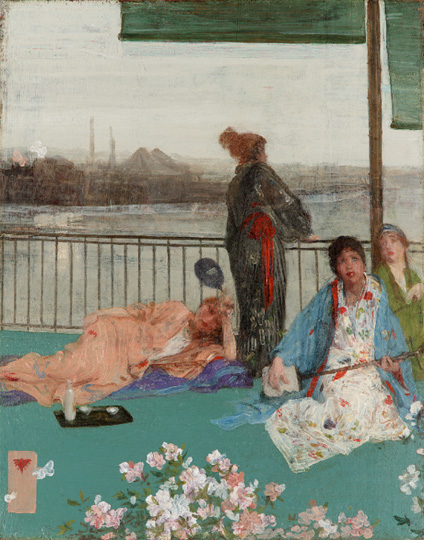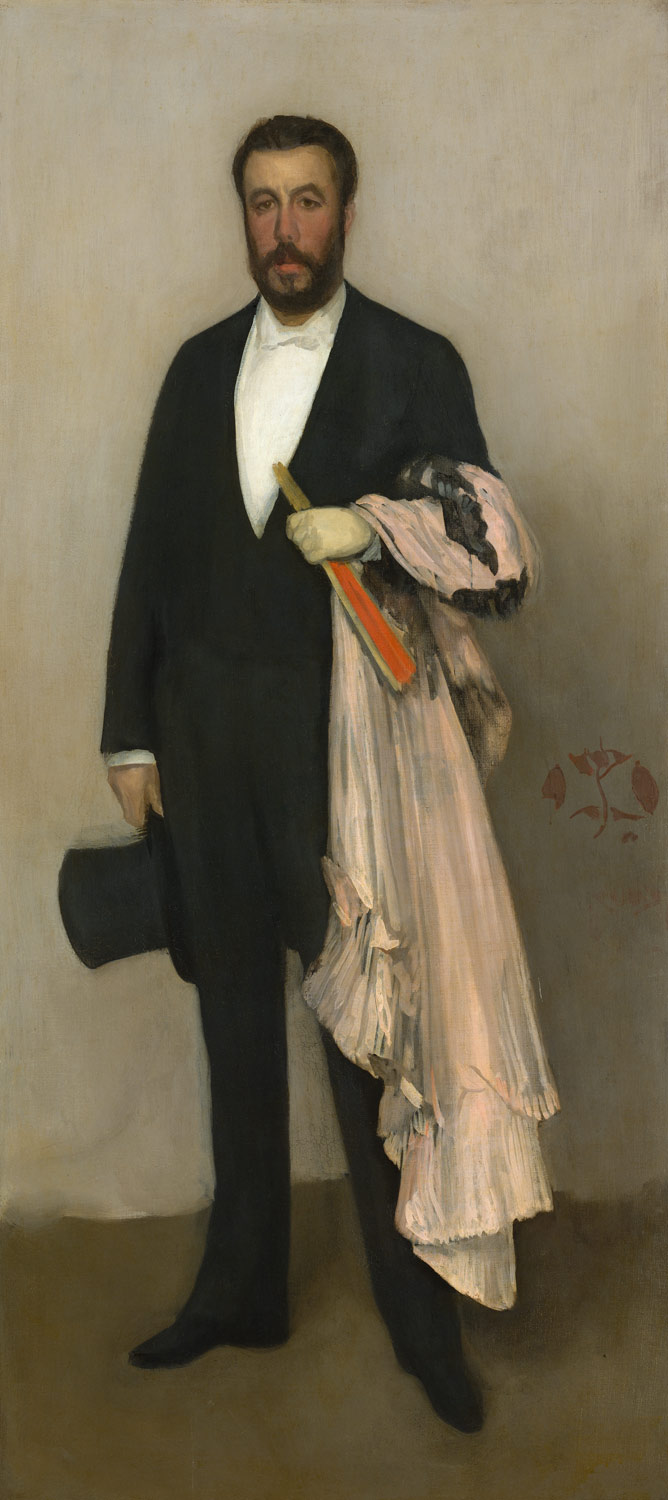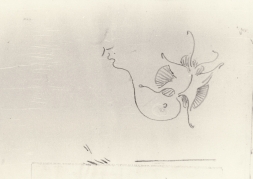The author of this blog is Polina Atabekian, a third year honours student in the School of Culture & Creative Arts, University of Glasgow.

Variations in Flesh Colour and Green – The Balcony 1864-1873 Oil on canvas. Freer Gallery of Art, Gift of Charles Lang Freer, F1892.23a-b
The lepidopterous monogram of James McNeill Whistler first made its appearance in Variations in Flesh Colour and Green: The Balcony (Freer Gallery of Art), a painting dated somewhere between 1864 and 1873: however the butterfly may have been added later – possibly for an exhibition. [1] Since then the miniature detail has sparked a massive interest across Whistler’s community.
The aim of this blog post is to investigate the famous butterfly signature that made its perch on Whistler paintings, drawings, etchings, and correspondence, and its development (in both design and meaning) over time.
La Princesse du pays de la porcelaine (1863-65, Freer Gallery of Art) demonstrates the rather large signature that preceded the butterfly. Upon D. G. Rossetti’s unsuccessful first attempt to sell this painting, due to the collector’s objection to the large “Courbet-like” signature, Rossetti had reached out to Whistler that if he were to change the signature, the collector would agree to purchase it. After being met with a furious reaction from Whistler, the painting was eventually sold to a different collector. Nonetheless, it must have gotten Whistler thinking about whether such a large signature had a negative effect on the painting. He considered using his initials instead. The initials J.W. were eventually transformed to form a butterfly – the ‘J’ became the torso, and the ‘W’ became the wings. It is unclear what exactly inspired Whistler to opt for the famous butterfly form, although his mother, Anna Matilda Whistler had called him a “butterfly” when he was younger. [2]
In Variations in Flesh Colour and Green: The Balcony (Freer Gallery of Art), the first painting where the Whistler monogram appears, the butterfly is positioned within an oblong frame of the same colour as one of the model’s kimonos, resembling the signatures found in Japanese woodblock prints that could have served as inspiration. A further example of this format can be found in the Nocturne in Blue and Silver (1871-72, Fogg Art Museum).
Grischka Petri adds that the emergence of the butterfly signature had to do with the artist’s tactical marketing. A detail that would bring none other than its maker to mind fell perfectly in line with Whistler’s ambitions to establish his unique public image. Together with the musical titles for his pieces, the butterfly signature provided the perfect potion to woo the art market.
One might say that a butterfly only becomes a butterfly at the final stage of its metamorphosis, but not Whistler’s. The design of the butterfly would change over the following 30 years: what started out by resembling a dragonfly gradually transformed itself, rather dramatically, to acquire antennae, veins, and eventually a tail.
In the Arrangement in Grey and Black no. 2: Portrait of Thomas Carlyle (1872, Glasgow Museums) the Butterfly is shown to have been freed from its previous rectangular confinement and acquired a more convincing butterfly shape.
But just how freely did the Butterfly soar? The Pennells would recall:
“It was introduced as a note of colour, as important in the picture as anything else and at times it was put in almost at the first painting to judge the effect, scraped out with the whole thing, put in again somewhere else, this repeated again and again until he got it right. We have seen many an unfinished picture with the most wonderfully finished Butterfly, because it was where Whistler wanted it.”
The Butterfly became a significant detail, and Whistler’s emphasis on where it was placed further confirms Petri’s theory of its marketing function – it needed to be seen.

Arrangement en couleur chair et noir: Portrait de Théodore Duret, 1883/85, Oil on canvas, Metropolitan Museum of Art, NY., Catharine Lorillard Wolfe Collection, Wolfe Fund, 1913, 13.20
10 years after the initial appearance of the butterfly signature, in Arrangement en couleur chair et noir: Portrait de Théodore Duret (1883-1885, Metropolitan Museum of Art, NY) the butterfly signature is executed in red, in a slight contrast to the overall tone of the painting. However, in A Grey Note: Village Street (1884, The Hunterian, University of Glasgow) the signature is shown intricately incorporated and in tone with the painting. While both of these images served to market the artist in one way or another, the higher saturation of the signature on the portrait of Théodore Duret could imply the artist’s intention to attract more commissioned portraits, whilst using the signature as both a trademark and advertisement simultaneously.
However, was signing the painting with the butterfly simply about the marketing? An easier, recognisable way to sign a painting? Or did the butterfly carry within its wings a more intrinsic, sentimental meaning? Mortimer Menpes, one of Whistler’s faithful followers describes his time with Whistler:
“ …he (Whistler) taught me what was meant by artistic placing and balance. Indeed, Whistler very rarely placed his butterfly on a picture without first saying to me, “Now, Menpes, where do you think the butterfly is going this time?” It used to be a little joke between us, and after some months of habit I was invariably able to put my finger on the spot where the butterfly should be placed to create the balance of the picture.” [5]
It seems that Whistler’s butterfly was a detail, the intricacies of which the artist was willing to share, and his involvement of other artists working beside him shows a sentimental side to this delicate creature. Some went as far as to say that Whistler had begun to identify himself with the butterfly signature.
Several scholars referred to Whistler as the Butterfly in chapters referring to his life during the 1870s or in books regarding Whistler’s correspondence or design. What can either be an allusion to the artist’s character, or the state of his career in that moment in time, what can be said for sure is that it was in no way a reference to his lifespan!
But did Whistler see just himself behind the Butterfly? When he married Beatrice Godwin (née Philip) in 1888, his signature changed. The butterfly alighted on top of a trefoil styled to resemble her maiden name initials ‘BP’.
In a letter to Gertrude Elizabeth Campbell, Whistler speaks about the trefoil detail:
“…For You know the Trixie is my ‘Luck’ – – and see how well the trefoil and the butterfly belong “ [6]
James McNeill Whistler and Beatrice Whistler, View from the chateau walls, Loches, 1888, Etching, The Hunterian, GLAHA 45151
On their honeymoon, Whistler had taught ‘Trixie’ how to etch, and as the years went by she had worked alongside him. View from the chateau walls, Loches (1888, The Hunterian, University of Glasgow), the only known work on which both Whistler and Beatrice collaborated, is signed with the trefoil butterfly. Even after Beatrice’s death, Whistler continued to use the trefoil in his signature format.
In later butterflies, the trefoil was always present, in the most simplest of butterflies as well as those more defined with wings and antennae. One could say the butterfly was no longer about recognizing the work as a Whistler, but rather recognizing Whistler within it.
However, these fascinating creatures were no longer used just to sign his paintings, in fact, a large proportion of his correspondence dating from after the 1870s was signed with this monogram. But something was different, the fluttering butterfly that graced us with its presence across his paintings had grown a mischievous stinging tail.
“Were I too, my dear Whistler, the airy happy thing you are – the butterfly basking in the sunshine of life – flitting daintily & jauntily about for very joy & stinging for very malice.” [7]
As is mentioned in this letter from Marion Henry Spielmann, it seems that this stinging detail on the butterfly perfectly conveyed the artist’s personality in the eyes of his peers and enemies. The question remains whether this parallel was created by his surroundings and appropriated by Whistler, or deliberately implemented by the artist himself.

James McNeill Whistler, Butterfly , drawn for publication in 1890, pencil with white paint on card, E. R. & J. Pennell Collection, Library of Congress, Washington, DC, ND 237/W6A2/1899a/P&P/Pennell (M.1250)
The artist’s correspondence, particularly with members of the press, became the natural habitat for the stinging-tailed butterfly, ready to strike at any moment. Over the course of forty years, Whistler compiled the correspondence between him and the press, and he didn’t hesitate to refer back to what he considered to be audacious claims towards his work. A sampling of these were published in his book The Gentle Art of Making Enemies in 1890.
In collaboration with his editor, Whistler was able to justify his aesthetic goals whilst uncovering the crude intentions of the critics and others who doubted him within the pages of this book. The omnipresence of the butterfly within the work is described by Pennell:
“They danced, laughed, mocked, stung, defied, triumphed, dropped wings over the farthing damages, spread them to fly across the Channel, and expressed every word and almost every thought.” [8]
The butterfly in this case is augmented, the wings and antennae as well as the stinging tail bent and twisted to convey a certain mood. Making its perch across the pages next to the artist’s reflections on a particular letter, Whistler fluttered into the margins and exposed the philistines, a predecessor of a present-day Twitter thread.
Revisiting Petri’s theory of marketing intent behind the butterfly, it is possible that by signing his letters (which then got published) the same way he signed his paintings, the artist was building brand recognition of all things Whistler.
NOTES: 1. Margaret F. MacDonald, Grischka Petri, James McNeill Whistler: The paintings, a catalogue raisonné, University of Glasgow, 2014, (cat. no. YMSM 56). Pennell, Elizabeth Robins and Joseph Pennell. The Life of James McNeill Whistler, by E.R. and J. Pennell. London: Heinemann, 1908. Vol. 1, pp. 124-25.
2. GUW 06451.
3. Petri, Grischka. Arrangement in Business: The Art Markets and the Career of James McNeill Whistler. Hildesheim: Georg Olms Verlag, 2011. p. 165
4. Pennell, op. cit, p. 125.
5. Menpes, Mortimer and Dorothy Menpes. Reminiscences of Whistler. London: Charles Holme, 1903. p. 254.
6. GUW 00511.
7. Glasgow University Library, MS Whistler M102.
8. Pennell 1908, op. cit., p. 106.
GUW = The Correspondence of James McNeill Whistler, 1855-1903, edited by Margaret F. MacDonald, Patricia de Montfort and Nigel Thorp; including The Correspondence of Anna McNeill Whistler, 1855-1880, edited by Georgia Toutziari. On-line edition, University of Glasgow. http://www.whistler.arts.gla.ac.uk/correspondence

